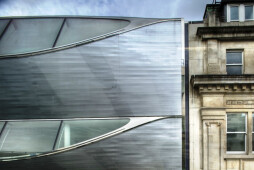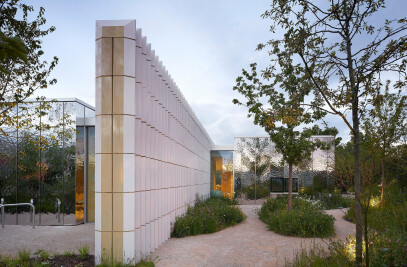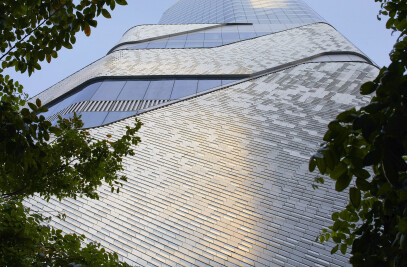Many narrow streets and alleyways off Oxford Street, London are currently misused and underdeveloped. These under regarded areas are ideal not only for improvement, but also for relatively unconventional design opportunities. Our proposal acknowledges this by providing an architectural intervention that subtly draws attention to the building through the intrigue of a sculptural façade. Inspired by the art work of Lucio Fontana large glazed areas orientated towards the sky are slashed into the façade, maximising the natural light available in this narrow street. This sculptural form is achieved using a system of aluminium profiles used in the production of high quality, ship hulls. The facade is fabricated using curved 140mm wide aluminium profiles that are connected together on-site, using a tongue-and-groove system ensuring water-tightness and construction efficiency. The metallic silver finish is a high performance durable paint typically used on super yachts. The use of self cleaning glass and an ingenious detail of hidden gutters within the eyelids ensures the facade remains low maintenance. The ground floor is fronted by a bespoke laminated glass in which is sandwiched a stainless steel mesh and semi opaque interlayer over a dichromatic film. This is lit from behind, using fibre optics to generate a coloured moiré pattern providing dynamic visual interest and a feeling of depth to what would otherwise be a blank wall.
| Element | Brand | Product Name |
|---|---|---|
| Internal lighting | Modular Lighting Instruments | |
| Resin | Bolidt | |
| Raised floor | Kingspan Group | |
| Steel mesh | Cadisch MDA | |
| Chilled beams | SAS International | |
| Iron mongery | Allgood |
Amanda Levete made four glass cuts in the façade of the office building at 10 Hills place, one of the many narrow side streets of Oxford street in London. Like funnels, they let the daylight fall deep into the office.
The façade is both striking and sculptural. Curved profiles form the basis of the construction, a building method used in yachting for building hulls. Brass and grooves make a waterproof and constructive façade. A metallic yacht paint was used for the finish. There are gutters under the windows to prevent dirt collecting from the rain. The glass is self cleaning. The ground floor is animated with color effects. The ground floor façade is made from different layers of glass with a steel net incorporated. The lighting from the rear creates a dynamic moiré effect.
Diagram references 1 Galvanised steel fin bolted on the main bearing structure 2 Round aluminium bearing structure 3 Aluminium profile brass and groove 140 mm 4 Structural tubing with fireproof coating 5 LED lights 6 Steel reinforced concrete floor 7 Rubber seal 8 Terminal profile 9 Stainless steel finish 10 System ceiling 11 Polished stainless steel shoe 12 3-layer laminated glass 13 Perforated steel plate 1mm 14 Stainless steel gutter 15 Drainage
FRENER & REIFER was commissioned to carry out the detailed design planning, structural analysis and realisation, including assembly and manufacturing, of the building envelope and all facade work for the refurbishment and extension of an office building situated near Oxford Circus in the heart of London.
The polished high gloss stainless steel cladding, the sloping “eyelid” skylights, the curved aluminium “eyelid” cladding and the freeform sheet metal parapet cladding are all immediately noticeable features of this strikingly modern facade.
The “eyelids” are inclined glazed ovals without cover strips, featuring a load-bearing steel substructure and supported internally by concave glass fins. The all-over cladding of the “eyelid” facades forms a waterproof plane with no visible joints; the first use of a butt-jointed aluminum cladding system adapted from shipbuilding in a facade. The panels feature a special high gloss spar varnish coating creating a mica effect. The three-dimensional curvature of the panels varies from floor to floor and the connection between the facade and the glass "eyelids" was achieved using polished stainless steel edging.
FRENER & REIFER was also responsible for the development and realisation of the 3-dimensionally curved roof parapet cladding, using the architects’ 3D surface model to implement the curved free form sheet geometry at the upper “eyelid” terminations.
The illuminated ground floor facade, with its profile-free floor to ceiling glazing, stainless steel mesh and dichroic color effect, and the entrance area with its bespoke flush doors, also featuring the special ground floor facade glass, are also of particular note.
The site location, just off Oxford Street in central London, was a challenging one, requiring well-coordinated “just in time“ deliveries to overcome the problems of restricted access and lack of storage space. Despite this, all refurbishment and extension work was carried out without disrupting retail operations on the two floors below.
Project Name: 10 Hills Place
Client: Puzzle Investments Limited, Dublin, Ireland Project Manager: Jeffery Messem
Architect: Amanda Levete Architects / (Future Systems), London, UK Project Manager: Ho-Yin Ng
Building Envelope/Facade Construction: FRENER & REIFER Metallbau, Bressanone, Italy Project Manager: Carsten Haedge
Work: Glass and metal cladding with three-dimensional surface
Technical data:
- total facade area 670m ² - building height 23m - building width 27m - maximum glass dimensions 3 x 3m
Hodgson & Hodgson Group Ltd. were commissioned to undertake an Environmental Noise Assessment for the development and provide comprehensive design advice throughout the project. 10 Hills Place is a contemporary and exciting development. The modern eye catching design incorporates an external façade of metal and glass which illustrates buildings can look attractive and provide sufficient sound insulation properties even in the most challenging noise environments. The acoustic challenge for us was that the unique design of the building would throw up specific acoustic issues. We needed to consider and overcome these issues to ensure the internal noise levels within the office space, from potentially high external noise levels, met relevant British Standard criteria. In turn we would provide a comfortable working environment for the future businesses within 10 Hills Place. We engaged this challenge from two angles, firstly recommending a glazing specification and secondly providing comprehensive design advice for the external façade that incorporated curved aluminium profiles. The dominant noise source affecting 10 Hills Place was the bustling commercial area of Oxford Street in London’s West End. The noise levels were measured and after considerable data analysis we recommended a glazing specification that when incorporated in the external façade allowed the relevant criteria to be met. The second half of the story was to provide prompt, comprehensive and robust acoustic design advice to the architects. This ensured the construction detail of the external façade would compliment the glazing and offer significant protection from noise inside the offices. We achieved this by making slight adjustments to the proposed design and calculating the sound reduction of the tweaked design. Ultimately, we derived a specification which achieved the criteria and delivered our recommendations on time.

Futuristic ISMs meet architectural demands at iconic Hills Place development
SAS International as Chilled beamsIntegrated Service Modules (ISMs) featuring both active chilled beams and Micro Prism Optic (MPO) luminaires were installed as part of an iconic refurbishment and extension project at 10 Hills Place, Oxford Street, London. Leading architectural and design practice, Amanda Levete Architects, specified over 200 metres of SAS International’s futuristic ISMs for the recently completed project. This striking 1300m2 office refurbishment and extension with its billowing facade is situated behind an existing six-storey block and above two floors of retail space off Oxford Street in the Noho (North of Soho) area. Ho-Yin Ng, Director at Amanda Levete Architects comments: “Bespoke integrated chilled beams which combined the electrical and mechanical systems of the cooling, ventilation and lighting were designed and developed with SAS into a slim line aerodynamic profile. This matched the aesthetic of the building, whilst maximising headroom and areas of the soffit, leading to an increased sense of space.” Tony Martin at M&E Consultants, the Barn Partnership, comments: “Integrated Service Modules have provided the best solution for this project based on the floor to ceiling height and the decision to leave the soffit uncluttered.” The active chilled beams provide 470 W/m of cooling and 370 W/m of heating to the internal envelope. Supplied and installed by SAS Project Management, the energy-efficient active ISMs were able to match the modern architectural aesthetics, while achieving correct environmental comfort and illuminance (lux) levels. The ISMs generate minimal air movement and noise, thus providing a flexible solution increasing the comfort and well being of occupants. “Our aim was to maximise the natural light into the office space from the narrow street. This was achieved by angling the windows towards the sky and maximising the floor to ceiling heights within the building,” added Ho-Yin Ng. The facade is fabricated using curved aluminium profiles assembled onsite. The fine faceting of the aluminium strips creates beautiful and complex reflections of sky and street, making the building highly visible from Oxford Street. The office was designed for Clarendon Properties.
Project Spotlight
Product Spotlight
News
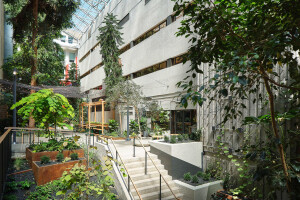
Taktik Design revamps sunken garden oasis in Montreal college
At the heart of Montreal’s Collège de Maisonneuve, Montreal-based Taktik Design has com... More
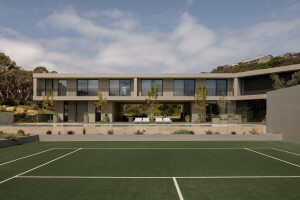
Carr’s “Coastal Compound” combines family beach house with the luxury of a boutique hotel
Melbourne-based architecture and interior design studio Carr has completed a coastal residence embed... More
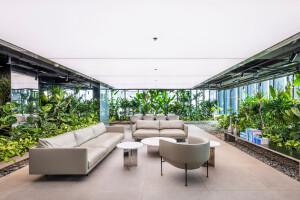
Barrisol Light brings the outdoors inside at Mr Green’s Office
French ceiling manufacturer Barrisol - Normalu SAS was included in Archello’s list of 25 best... More
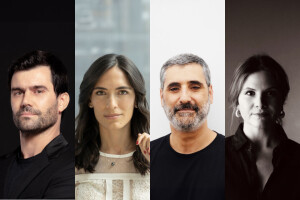
Peter Pichler, Rosalba Rojas Chávez, Lourenço Gimenes and Raissa Furlan join Archello Awards 2024 jury
Peter Pichler, Rosalba Rojas Chávez, Lourenço Gimenes and Raissa Furlan have been anno... More

25 best decorative glass manufacturers
By incorporating decorative glass in projects, such as stained or textured glass windows, frosted gl... More

Introducing Partner Geopietra
Geopietra® is an international brand and an Italian company founded in 1996, specialized in the... More
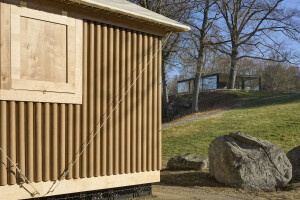
Shigeru Ban’s Paper Log House at Philip Johnson’s Glass House
In New Canaan, Connecticut, Shigeru Ban: The Paper Log House has opened as part of the 75th annivers... More
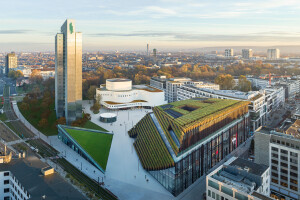
10 commercial buildings that benefit from planted facades
The integration of nature into architecture marks a proactive urban response to the climate emergenc... More


